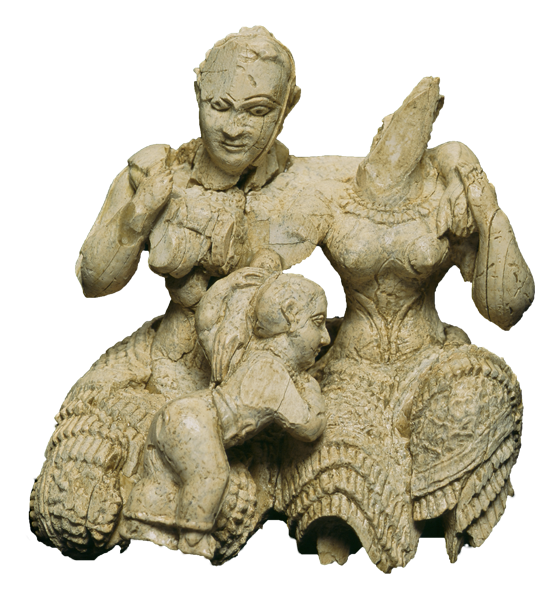Exhibit of the month
Terms of endearment …
Ivory figurine representing three female figures
National Archaeological Museum
Collection of Prehistoric Antiquities, inv. no. Π7711
Provenance: Mycenae; north slope of the Acropolis, close to the megaron
Dimensions: Height: 7.8 cm, Length: 7 cm, Width/Thickness: 5.5 cm
Date: 15th-14th c. BC
Display location: Exhibition of Mycenaean Antiquities, Room 4, showcase M18.
Ivory figurine representing a group of three female figures. This is the so-called “ivory triad”, a unique masterpiece of Mycenaean art. Despite the fact that any evidence of other material inlaid in the surface of the figurine is lost, this work of art is characterized by exquisite plasticity and impressive movement.
Two adult women are portrayed squatting, bending their knees, embracing each other: one woman has laid her arm around the shoulder of her companion. They both wear the well-known Creto-Mycenaean garb with the tight short-sleeved bodice and the characteristic richly pleated skirt. They share an oblong estheta (shawl) that joins the two women on the back, starting from the shoulder of the first figure and ending in the waist of the other .
Before the two kneeling women, a little girl is shown trying to stand up: she wraps her arm around the arm of one of the women who keeps her from falling, thereby indicating the tender age of the toddler. Alan Wace, the archaeologist who unearthed the ivory group on the north slope of the acropolis of Mycenae in 1939 believed that it depicted a sacred triad of goddesses. Even though the identities of the three figures cannot be established, it is obvious that the figurine illustrates an affectionate scene between the three females, who may represent three generations of the same family, since one of the adult women looks older than the other.
The little girl of the “ivory triad” is clad in a plain thin chiton that reaches the ankles, girdled around the waist with a simple cord. This was the most common Mycenaean garment, with or without belt, that was depicted worn mainly by women and toddlers portrayed in figurines and apparently corresponds to the Homeric eanos . It is also interesting that the child’s neck is adorned with a bead necklace. Research conducted on children burials confirms that the children wore pendants and beads (usually of cornelian and blue glass paste) as necklaces and bracelets that evidently served decorative as well as apotropaic purposes.
Representations of children in the Creto-Mycenaean art are rare, but defined by a major difference between the two genders. As a rule, little boys are depicted nude, like the young “Boxers” of Akrotiri on Thera, who wear only their athletic gear (belt and gloves), but also jewels (necklace, armlet, bracelet and anklet). Girls are always shown dressed, usually wearing simpler versions of garments intended for adult women, as in the case of a ring from Mycenae. With the exception of the exposed breasts of some adult women who seem to play a specific role in the sphere of religion , images of totally naked female figures are lacking in Mycenaean iconography, a fact that unquestionably reflects a conscious social convention according to which women’s bodies had to be garbed.
Dr Vassiliki Pliatsika
Bibliography:
Wace H., Ivories from Mycenae No1: The Ivory Trio, 1939.
Wace A.J.B., Mycenae. An Archaeological History andGuide, New York1949, 83-84, figs. 101-103.
Poursat J.-C., Catalogue des ivoires mycéniens du Musée National d’Athènes, Athènes 1977, 20-21 no. 49, pl. IV.
Rutter J., “Children in Aegean Prehistory” στο Neils J, Oakley Jen., Oakley John (eds.), Coming of Age in Ancient Greece: Images of Childhood from the Classical Past, New Haven and London 2003, 30-57.
Rehak P., “Childrens’ Work: Girls as Acolytes in Aegean Ritual and Cult” στο Cohen A., Rutter J. (eds.), Constructions of Childhood in Ancient Greece and Italy (Hesperia Supplement 41), Princeton, New Jersey 2007, 205-225.
Pomadère M., “Dressing and Adorning Children in the Aegean Bronze Age: Material and Symbolic Protections as well as Marks of an Age Group?” στοNosch, M.-L., Laffineur R. (eds.), Kosmos: Jewellery, Adornment and Textiles in the Aegean Bronze Age. Proceedings of the 13th International Aegean Conference/13e Rencontre égéenne internationale, University of Copenhagen, Danish National Research Foundation’s Centre for Textile Research, 21–26 April 2010,Aegaeum 33, Leuven and Liege 2012, 433–439 (pl. CII).


